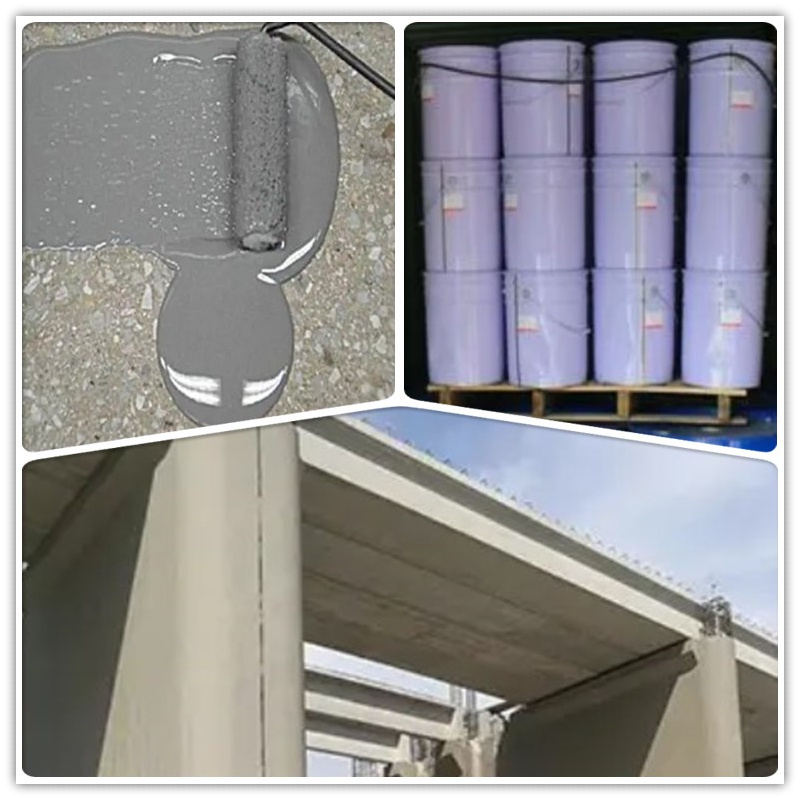Anti-carbonation coating for concrete

Keywords
Anti-carbonation coating for concrete, carbonization of concrete
Concrete anti-carbonization coating is a new compound of organic chemistry and inorganic materials. It is coated on the surface of concrete and firmly bonded to it to produce a tough coating protective layer with high strength, tenacity and durability, which can reasonably block carbon dioxide and fluorine in the natural environment. Corrosion of concrete by corrosive substances such as chemicals, O2, sea surface, and acid rain hazards.
Usage
Waterproof and anti-carbonation protection of various reinforced concrete, masonry and other structures, including cast-in-place concrete, precast concrete, prestressed concrete, etc.;
Concrete anti-carbonation coatings can also be used for waterproofing and anti-carbonation protection on the surface of wood, gypsum board, MDF, metal, and chalked walls;
It is especially suitable for preventing the infiltration of rainwater into the wall caused by wind pressure.
Carbonization of concrete
It means that the concrete itself contains a large number of capillary pores, and the carbon dioxide in the air reacts with the free calcium hydroxide inside the concrete to form calcium carbonate, which causes the concrete to loosen and fall off. After carbonization, the alkalinity of concrete is reduced. When carbonization exceeds the protective layer of concrete, in the presence of water and air, concrete will lose its protective effect on steel bars, thereby causing steel bar corrosion, shrinkage cracking, and even gel structure. disintegration and other issues.
Mechanism
Carbonized emulsion-modified cement-based polymer composites, the emulsion contains unique copolymerization components, which cause cross-reaction chains in the cement to form a polymer-cement hydrate intertransmission network structure, resulting in chemical and mechanical cohesion and adhesion. Focusing on improving the tensile strength and bonding strength, it is coated on the concrete surface and firmly bonded to form a high-strength, tough and durable elastic coating film protective layer, which can effectively prevent carbon dioxide, chloride, oxygen, seawater, acid rain, etc. in the environment. Erosion of structural materials by corrosive media.
Material compositions
It is composed of high-performance polymer emulsion, various additives and modified cement-based materials. After the coating is cured, it is a new type of protective sealing material that has both the flexibility of polymer materials and the high durability of inorganic materials.

Keywords
Anti-carbonation coating for concrete, carbonization of concrete
Concrete anti-carbonization coating is a new compound of organic chemistry and inorganic materials. It is coated on the surface of concrete and firmly bonded to it to produce a tough coating protective layer with high strength, tenacity and durability, which can reasonably block carbon dioxide and fluorine in the natural environment. Corrosion of concrete by corrosive substances such as chemicals, O2, sea surface, and acid rain hazards.
Usage
Waterproof and anti-carbonation protection of various reinforced concrete, masonry and other structures, including cast-in-place concrete, precast concrete, prestressed concrete, etc.;
Concrete anti-carbonation coatings can also be used for waterproofing and anti-carbonation protection on the surface of wood, gypsum board, MDF, metal, and chalked walls;
It is especially suitable for preventing the infiltration of rainwater into the wall caused by wind pressure.
Carbonization of concrete
It means that the concrete itself contains a large number of capillary pores, and the carbon dioxide in the air reacts with the free calcium hydroxide inside the concrete to form calcium carbonate, which causes the concrete to loosen and fall off. After carbonization, the alkalinity of concrete is reduced. When carbonization exceeds the protective layer of concrete, in the presence of water and air, concrete will lose its protective effect on steel bars, thereby causing steel bar corrosion, shrinkage cracking, and even gel structure. disintegration and other issues.
Mechanism
Carbonized emulsion-modified cement-based polymer composites, the emulsion contains unique copolymerization components, which cause cross-reaction chains in the cement to form a polymer-cement hydrate intertransmission network structure, resulting in chemical and mechanical cohesion and adhesion. Focusing on improving the tensile strength and bonding strength, it is coated on the concrete surface and firmly bonded to form a high-strength, tough and durable elastic coating film protective layer, which can effectively prevent carbon dioxide, chloride, oxygen, seawater, acid rain, etc. in the environment. Erosion of structural materials by corrosive media.
Material compositions
It is composed of high-performance polymer emulsion, various additives and modified cement-based materials. After the coating is cured, it is a new type of protective sealing material that has both the flexibility of polymer materials and the high durability of inorganic materials.
Supplier's popular products
Contact Supplier
We have more categories for you. lf you can't find the products you want above,just fill in the form and tell us whatproducts you want to import from China.















